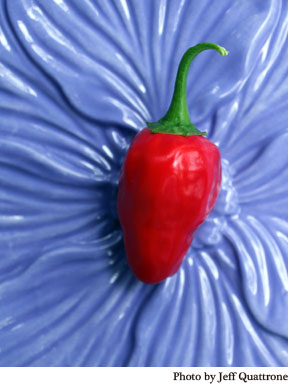Fermenting Hinkelhatz
 No, it's not the title of a new Christopher Guest film. It's another self-induced adventure that I get to write a story about. You know the saying you just can't make this up, well I sorta do by growing my own content.
Hinklehatz peppers, aka Chicken Heart Peppers are a very old Pennsylvannia Dutch heirloom. (If you click the link scroll about halfway down to the description.) Or, you can keep reading this;
No, it's not the title of a new Christopher Guest film. It's another self-induced adventure that I get to write a story about. You know the saying you just can't make this up, well I sorta do by growing my own content.
Hinklehatz peppers, aka Chicken Heart Peppers are a very old Pennsylvannia Dutch heirloom. (If you click the link scroll about halfway down to the description.) Or, you can keep reading this;
These hot peppers have been cultivated in this area for over 150 years! Its name perfectly describes the shape and size of these extremely hot peppers. These hot little beauties are used almost exclusively in pickled form by the PA Dutch, although they also cook and puree the peppers to make a "pepper vinegar" similar to Tabasco sauce, which is used on sauerkraut and other dishes. A recipe appears in 1848 in Die Geschickte Hausfrau. Prolific, long-season plants. Very ornamental, on compact 1-1/2 to 2 foot bushes. Very resistant to all bugs and disease. Also very cold hardy for a chile pepper.
What the above fails to mention is the name, Hinklehatz, translates into chicken heart because the peppers are very close to to size, shape and color, if it's the red variety, of a chicken heart. They rate 125,000 units on the Scoville scale. They are very serious hot peppers.
The description of the plant is accurate. A large, sturdy bush that withstood the following; a hail storm that killed the rest of my garden, then torrential rains, a hurricane that passed within 60 miles of it where it was growing, and finally the remnants of a tropical storm. The pepper itself has a very tough skin. The flavor is somewhat fruity until the caspian kicks in and reminds you of it's ranking on the Scoville scale.
A friend mentioned that one day she wanted to ferment some hot peppers into a sauce. That got me thinking about trying that with the hinkelhatz. Since the Pennsylvania Dutch use these peppers for hot sauce and pickling vinegars, it seemed like a good fit for these peppers.
The Pennsylvania Dutch are stewards of heirloom varieties. Their contribution to the preservation of heirloom varieties is a standard that I hope a lot of people follow. It's essentially what the focus of this project is all about. That is growing varieties of plants with a history and tradition, and passing them along to future generations. I'll write more about the Pennsylvania Dutch and their varieties in the future. For now though, let's get back to fermenting hinklehatz.
I started out inspired. I wanted to work with the fruity notes in the flavor of the pepper, so I decided to use a locally grown canary melon. I would've used one that I grew, however the previously mentioned hail storm took them out. If you never had a canary melon, you are missing out on a very sweet melon, with a robust and deep melon flavor. Some bay leaf, black pepper, garlic, shallots, and some black cherry tomatoes would round out the sauce.
I would attempt to do some food styling for the photographs. I was going to ferment for 30 days. A complete month of fermenting, and document the process with weekly photos. It was going to be the best hot sauce ever.
As would be the case in any story, an antagonist would arrive on the scene muck up the works. In this story, it arrived in the form of yeast. The yeast formed from not having a sealed jar, and brine that lacked enough salt. There wasn't much information out there about fermenting hot peppers for sauce, and me being impatient and impulsive when it comes to being creative, I forged ahead with what little information I found.
Not that the yeast that grew was a bad thing, but it wasn't good either. So I did some more digging for information, or excavating is more like it, and found this site. It was here that I found the information that identified the yeast. After reading through this page I saw the errors of my way. If you want to try this, it seems like this page is a solid source of information. I haven't gone back to try this yet, perhaps I will since the plant I have still has a lot of hot peppers on it.
I thought the story was done, however as it will be, innocently enough at a pot luck dinner at a friend's house, another friend was talking about the hot peppers she grew. She mentioned how she would put them in a jar with some sherry and making a spicy cooking wine. BINGO!, I had a solution to this story, so that's what I did. While not a hot sauce or a pickling vinegar in the traditional Pennsylvania Dutch vein, a delightful end to this self-induced hinkelhatz adventure.
